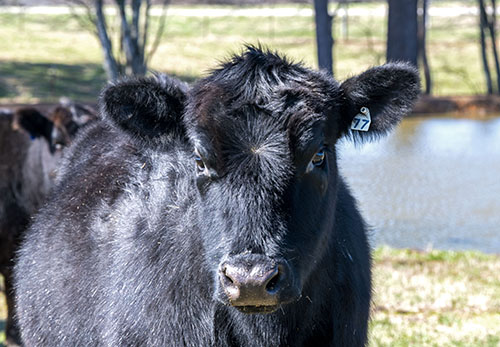Finishing Beef Cattle
May 01, 2023

Whether a producer is selecting a few animals to fill up the freezer for their family or selling beef direct to consumers, finishing and prepping calves for slaughter is a trend that continues to grow. With the goal of producing a carcass that has an ample yield of tender cuts juicy to the palate, careful feeding and management is essential. Finishing rations are all about high energy, especially compared to diets preferred for brood cows. Concentrating enough energy is the intent, as it is energy that allows for fat deposition to aid in juiciness. However, ruminant animals must be closely monitored to prevent health issues, such as reduced ruminal pH and acidosis rising from high-grain rations.
Key Management Tips
• Obtain slaughter date
It is important to match the animal’s genetics/maturity to know how long of a feeding period will be required. Later maturing genotypes typically require longer finishing periods versus earlier maturing, English breeds. This will dictate the level of performance that must be realized to prevent either under- or over-finished animals. Many commercial locker plants schedule slaughter dates as much as a year out.
• Identify what feedstuffs will be available
Less days on feed generally require more grain than forage.
• Keep them high and dry
Providing a dry, well-drained pen protected from wind will improve performance and animal comfort.
• Quench their thirst
Water availability is very important. According to published data from Oklahoma State University, 1,000-lb. steers can consume 14-20 gallons of water per day (depending on temperature).
• Acclimate cattle to ration changes
Most growing diets are higher forage/fiber rations with lower amounts of starch (grain). Incorporating more grain into the diet should be gradual over approximately 12-15 days. Acclimated animals should be offered a finishing ration for ad libitum consumption.
• Keep an eye on what they eat
Observing feed bunks are important for determining feed consumption adequacy. Cattle should be fed to approximately 2% overage. If cattle are out of feed for more than 2 hours within a 24-hour period, increase feed volume by 1 lb. of dry matter per day.
• Watch the fat
Cattle deposit fat in specific areas. Routinely observe cattle for signs of fat deposition, especially as its slaughter date approaches.
Your local Co-op has feeds specifically for this phase of beef production along with trained personnel to help formulate rations to meet the needs of the finishing program.
Key Management Tips
• Obtain slaughter date
It is important to match the animal’s genetics/maturity to know how long of a feeding period will be required. Later maturing genotypes typically require longer finishing periods versus earlier maturing, English breeds. This will dictate the level of performance that must be realized to prevent either under- or over-finished animals. Many commercial locker plants schedule slaughter dates as much as a year out.
• Identify what feedstuffs will be available
Less days on feed generally require more grain than forage.
• Keep them high and dry
Providing a dry, well-drained pen protected from wind will improve performance and animal comfort.
• Quench their thirst
Water availability is very important. According to published data from Oklahoma State University, 1,000-lb. steers can consume 14-20 gallons of water per day (depending on temperature).
• Acclimate cattle to ration changes
Most growing diets are higher forage/fiber rations with lower amounts of starch (grain). Incorporating more grain into the diet should be gradual over approximately 12-15 days. Acclimated animals should be offered a finishing ration for ad libitum consumption.
• Keep an eye on what they eat
Observing feed bunks are important for determining feed consumption adequacy. Cattle should be fed to approximately 2% overage. If cattle are out of feed for more than 2 hours within a 24-hour period, increase feed volume by 1 lb. of dry matter per day.
• Watch the fat
Cattle deposit fat in specific areas. Routinely observe cattle for signs of fat deposition, especially as its slaughter date approaches.
Your local Co-op has feeds specifically for this phase of beef production along with trained personnel to help formulate rations to meet the needs of the finishing program.